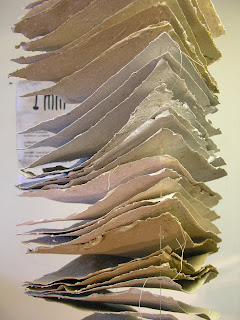The Installation is set up, ready for viewing and assessment. There will also be on Open Day at Hungate Dig on Saturday, 26th of January when you will be able to learn more about the archaeological site as well as view the installation.
 Archaeology – Art - Process Statement of Intent
Archaeology – Art - Process Statement of Intent
This installation was informed by my experiences during the student residency at the Hungate archaeological dig with the York Archaeological Trust (YAT). The intention was to respond to the finds, the ordinary domestic objects, their perceived significance and interpretation. As I was a novice in archaeology, I joined the volunteers in the summer and learned basic skills; how to correctly use a trowel to dig, to read the soil, to wash and sort the finds, to draw maps and describe contexts.
My artistic response developed through the process of using three separate media - photographs, drawing and papermaking – the unifying concept became ‘layers’, ‘time’ and ‘process’.
Photographs: layers of time and process:
The activity on site is fascinating and in constant flux. I intended to capture this activity, the textures, features and some of the archaeological processes performed on the site and in the HQ building. The resulting images are like palimpsests, reminiscent of the work of Indris Khan, with stratified, layered moments in time.


To view details of the site photograph click the following link: http://catherine-scriven.blogspot.com/2008/01/site-photograph-of-hungate-dig.html
To view details of the process photographs click the following link: http://catherine-scriven.blogspot.com/2008/01/archaeology-process-digital-prints.html
Drawing: process in layers of time:
The drawings are a response to the activity in the entrance hall, which I have been allocated for displaying my work. This is a changing, working environment where trays of finds are stacked to dry and safety clothing is available for use by those going on site. The objects in the drawings belong to different ‘layers of time’, from the Roman era to the present, the time span of the site itself. My drawing highlights the significance that these humble objects hold within a particular context. The act itself references the drawing process of mapping.


To see details of the drawings, click the following link: http://catherine-scriven.blogspot.com/2008/01/drawings-from-hungate-dig.html
Papermaking: paper core sample - a timeline of processed layers:
I am intrigued by the significance given by Cornelia Parker, Andy Goldsworthy and Arte Povera artists to ‘materials’ used within their work. I experimented with mud and grit, intending to embed the archaeological site into paper. This led to papermaking, thus recycling paper that was earmarked for disposal, either from domestic or corporate sources; representing various endeavours of humankind, such as finance, education, faith and music. Archaeologists refer to their activity as interpreting the rubbish from previous generations. The various soils used to colour the paper were also part of the spoils of the site, the rubbish from the archaeological process. Paper itself is transient. Recycling this rubbish is a way of investigating the significance of seemingly insignificant discarded material. It also questions the responsibility we have towards future generations, sustainability, and the legacy of our rubbish. The layers of paper are like a core sample of the site, the deposited layers of time, one millimetre corresponding to each year of the past.

The making of the paper became a repetitive process, with a performance on site shared with the volunteers and archaeologists. Through this performance I realised that the focus of the work shifted from objects to process and sharing of work practice. The emphasis was on the process itself, the tactile practical involvement, the human interaction, the social space. Paradoxically, the process produced an object, the paper. Interestingly, going full circle from object to process back to object.
This tactile paper also resulted in a book. To view images of the book and more of the layered paper please click the following link: http://catherine-scriven.blogspot.com/2008/01/timeline-of-processed-layers.html

































